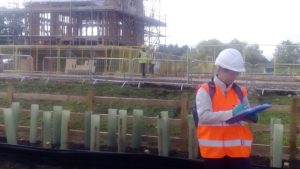An Odour Assessment Survey is an Essential Tool
An Odour Assessment Survey is an Essential Tool for Architects and your Customers, to Meet Planning and Permitting Conditions
There are a plethora of metaphorical hoops to jump through in your bid for a successful planning application. One such ‘hoop’, an odour assessment survey, is on the rise. Ever more, local authorities are adding it to the list of standard requirements when considering planning applications.
As an aside, local authorities also seem to be getting pretty hot on noise surveys too.
Meeting Planning Requirements
It’s a pretty good idea to conduct an odour assessment survey in the planning stages of any new development. But there are two particular types which benefit the most.
The first is when you’re working with an operator of an odorous process. Either in the development of a single new commercial property, or the alteration or expansion of an existing one. In this instance, any associated new process could have an odour impact on the local community. An odour assessment survey gives a qualitative analysis of that risk.
The second is for individual or very small housing developments. In this case, the residents of the proposed houses may become ‘receptors’ for existing odour producers. Here, an odour assessment survey gives a qualitative analysis of the potential odour impact of nearby businesses on the proposed development.
How Else is an Odour Assessment Survey Useful?
We’ve talked about the risk to your planning application of failing to allow for potential odour impacts. On the other hand, what happens if you proactively seek to mediate the risk of potential odour emissions? Well, a couple of things.
Firstly, you have an opportunity to engage with the local community. In turn, this can minimise the risk of opposition to your application. It can also help further along the line should you receive any odour complaints. This is because you’ll have a proven record of commitment to managing odours.
Secondly, It gives you a chance to factor in any odour abatement design features and procedures that may be needed. It’s a lot easier and cheaper to do so at the planning stage. Taking remedial action post-build is costly, challenging and can occasionally lead to legal proceedings.
How Does an Odour Assessment Survey Work?

An odour assessment survey is a comprehensive qualitative analysis conducted by highly experienced odour specialists. It considers;
• the potential impact of a new (or altered) property on the local community
• the potential impact of pre-existing businesses on a proposed development.
An odour assessment survey is conducted in line with all relevant guidelines. Namely, the Air Quality section of the National Planning Practice Guidance, and IAQM Guidance on assessment of odour for planning
Working on a Large Development?
While an odour assessment survey is an extremely useful and inexpensive tool, sometimes a more in-depth investigation is required. There are a comprehensive range of odour services which are of benefit in many different circumstances. If you’re working on a large or complex development, or just aren’t sure of the best approach, don’t worry. Our highly experienced team of odour experts work in conjunction with you to find the best solution.
Find Out More
Want to know more about the odour assessment survey, or our range of Odour Services? We’ll be glad to help.
Just give our odour team a call on 01525 351396 or email info@silsoeodours.co.uk.
Talk to us about Odour Assessment Surveys today

One Response
I had no idea that an architect had to do an odour sampling before they could build anything to make sure it was all clear. It’s interesting that odour control consultants assess the potential impact of a new property on the community and its impact on preexisting businesses. I wonder how exactly they do the assessment and what happens to the area if it doesn’t pass the inspection.